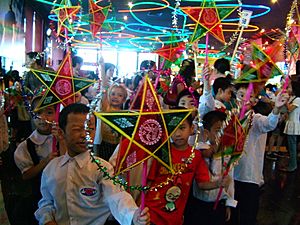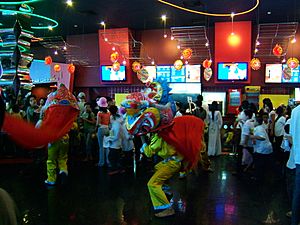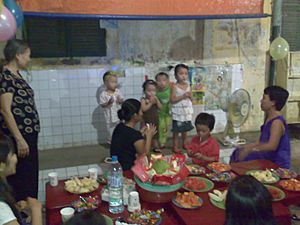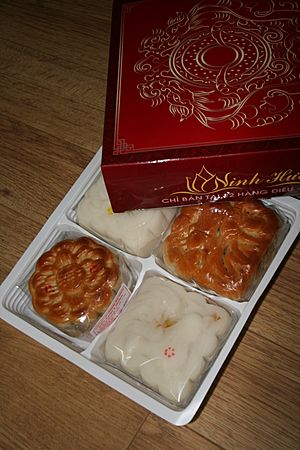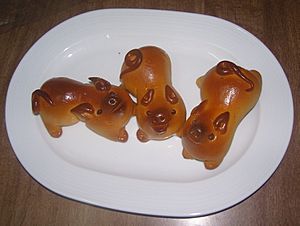Tết Trung Thu facts for kids
Quick facts for kids Tết Trung Thu (節中秋) |
|
|---|---|
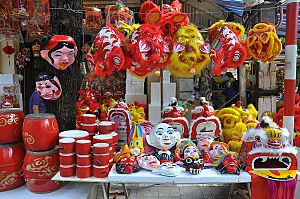
Children's toys during the Tết Trung Thu
|
|
| Official name | Tết Trung Thu |
| Also called | Tết Trông Trăng, Tết Hoa Đăng, Tết Đoàn Viên, Tết Thiếu Nhi or Tết Trẻ Con |
| Observed by | Vietnamese |
| Type | Festival culture, country |
| Observances | Making offerings to ancestors, making moon viewing, hanging lanterns, lanterns procession, lion procession, carp procession, trống quân singing. |
| Begins | the night of the 14th of the 8th lunar month |
| Ends | 15th day of the 8th lunar month (Rằm tháng Tám) |
| Date | Lua error in Module:Wikidata at line 132: attempt to index field 'wikibase' (a nil value). |
| Frequency | Annual |
| Related to | Mid-Autumn Festival (in China) Tsukimi (in Japan) Chuseok (in Korea) Uposatha of Ashvini/Krittika (similar festivals that generally occur on the same day in Cambodia, India, Sri Lanka, Myanmar, Laos, and Thailand ) |
Tết Trung Thu (Chữ Hán: 節中秋) is a special Vietnamese festival. It happens from the night of the 14th to the end of the 15th day of the 8th lunar month. This day is also called Rằm tháng Tám.
Even though it started in China, Tết Trung Thu has become a children's festival in Vietnam. It is also known as Tết Thiếu Nhi, Tết Trông Trăng, Tết Đoàn Viên, or Tết Hoa Đăng. Kids love this day because adults often give them fun toys. These toys include star lamps, masks, and special kéo quân lamps. Children also get to eat delicious bánh trung thu (moon cakes).
On this day, families gather to watch the full moon. When the moon is high in the sky, children sing and dance. In some places, people even have exciting lion dances or dragon dances for everyone to enjoy.
Contents
What are the Origins of Tết Trung Thu?
Tết Trung Thu first came from Chinese culture. There are three famous stories about how this festival began:
- The legend of Chang'e and Hou Yi.
- The story of Emperor Tang Ming Huang visiting the moon.
- The Vietnamese story of Uncle Cuội.
People in China have celebrated the harvest during the autumn full moon for a very long time. This started way back in the Shang Dynasty (around 1600–1046 BCE). The name mid-autumn (中秋) was first seen in the Rites of Zhou. This was a collection of ancient rituals from the Western Zhou dynasty. The festival became very popular during the early Tang Dynasty (618–907 CE). One story says that Emperor Emperor Xuanzong of Tang began formal celebrations after he explored the Moon-Palace.
According to a book called Việt Nam phong tục, the custom of hanging lights and having feasts came from old stories. These stories were about Emperor Tang Ming Huang. On his birthday, he told people to hang lights everywhere and have a big party. This tradition then became a custom.
The tradition of lantern parades started in the Song dynasty. This was because of a story about a carp that turned into a monster. This monster would harm people when the moon appeared. A mandarin named Bao Gong told people to make fish-shaped lanterns. They would carry these lanterns in the streets to scare the monster away.
The custom of trống quân singing also has an interesting origin. It goes back to the time of Emperor Quang Trung - Nguyễn Huệ. When he took his soldiers to the North, many of them missed their homes. Nguyễn Huệ came up with a way for soldiers to pretend to be boys and girls. They would sing and respond to each other to cheer up the soldiers. They used a drum for the beat, which is why it's called a trống quân (military drum).
Fun Activities and Customs
In the 19th century, Vietnamese people would offer food to their ancestors during the day. In the evening, they would have a feast to enjoy the moon. This feast included moon cakes and many colorful fruit cakes. Girls would show off their skills by peeling papaya into flower shapes or molding dough into shrimp and whale figures.
Children's toys for Tết Trung Thu are often made of paper. They are shaped like animals such as butterflies, elephants, lions, and fish. On the evenings of Tết Trung Thu, children play games like tug-of-war. They also have parades with lanterns, lions, and drums.
During this festival, people buy moon cakes, tea, and wine. They offer these to their ancestors when the full moon rises. People also give mooncakes, fruits, tea, and wine to their grandparents, parents, teachers, and friends. Chinese people often have dragon dances for Tết Trung Thu, while Vietnamese people have lion dances. The lion dance brings good luck and prosperity to families. In the past, Vietnamese people also enjoyed trống quân singing and kéo quân lantern displays. The drums for trống quân singing make a "thình, thùng, thình" sound.
According to Vietnamese custom, adults prepare parties for children to celebrate Tết Trung Thu. They buy or make many candle-lit lanterns to hang in the house. Children then carry these lights in parades. The Tết Trung Thu party usually includes moon cakes, candies, sugarcane, grapefruit, and other fruits.
Lantern Parades
In some villages, neighbors are very close. They often organize lantern parades for children to carry lights through the streets. Local governments or youth groups might start these lantern festivals. Everyone tries to have the biggest or prettiest lanterns in the parade.
In Phan Thiết (Bình Thuận), a huge lantern parade takes place. Thousands of elementary and middle school students march through the streets. This festival holds the record for the largest in Vietnam. It is a very old tradition, going back hundreds of years. The festival in Phan Thiết gets bigger every year. In Tuyên Quang, there is also a large lantern parade. People from different villages create their own lanterns, making it a very creative event.
Lion Dances
Lion dance performances usually happen before Tết Trung Thu. But the busiest nights for them are the 15th and 16th of the lunar month.
The Festive Party
A typical Tết Trung Thu party often features a dog made from grapefruit segments. It has two black beans for eyes. Around it, there are fruits and cakes like bánh nướng and bánh dẻo. Sometimes, there are vegetarian cakes shaped like a mother pig with piglets, or a carp. Grapefruit seeds are peeled and strung on wires. They are dried for a few weeks before the full moon. On Tết Trung Thu night, these strings of grapefruit seeds are lit up. Other important foods include bananas, nuggets, apricots, and pickled persimmons. Grapefruit is always a must-have fruit. When the moon is directly overhead, it's time to enjoy the feast!
The custom of watching the moon is also linked to the legend of Uncle Cuội on the moon. One day, Cuội was away, and his special banyan tree flew into the sky. Uncle Cuội held onto the roots but was carried up to the moon with the tree. If you look closely at the moon, you might see a dark spot. Children believe this spot looks like an old tree with Uncle Cuội sitting under it.
Making Tết Trung Thu Toys
Masks, lion lights, star lights, and lion heads are the most popular toys during the Mid-Autumn Festival. In southern Vietnam, the cities of Hội An and Saigon are famous for making decorative lanterns and paper lanterns for Tết Trung Thu.
Long ago in northern Vietnam, during a time when things were scarce (1976-1986), toys for children were very rare. Most families made their own toys. These included drums, lanterns, monk lamps, star lamps, kéo quân lamps, masks, tò he, and pinwheels. Some even made toy ship models. Masks were usually made from paperboard or cardboard. They often showed popular characters like lion heads, Ông Địa, Sun Wukong, or Zhubajie. Today, many toys in Vietnam come from China. These masks are often made of thin plastic.
The toy-making industry for Tết Trung Thu helps many small and medium businesses. It uses simple materials and technology, so it doesn't need a lot of money to start. For a while, Chinese toys were very popular in Vietnam. But by 2006, Vietnamese lantern makers recovered. They now sell most of their products in the local market again.
Types of Trung Thu Cakes (Moon Cakes)
Moon cakes have changed a lot over time. Makers now use many different ingredients for the filling. They also create cakes in many fun shapes and pack them in beautiful boxes. However, there are still only two main types of moon cakes based on how their crust is made: bánh nướng (baked cakes) and bánh dẻo (flexible cakes).
Bánh nướng
Bánh nướng have a crust made from flour and a little oil. The sugar used in the crust is usually cooked with malt. This makes it amber-colored and helps the cake last longer. In the past, the filling for these cakes often included lime leaves, fatty meat, jam, melon seeds, and sausages.
After shaping the cake and pressing it into a mold, it is baked in an oven. Baking happens in two steps. First, the cake bakes for about two-thirds of the total time. Then, it is taken out, cooled, brushed with egg yolk, and baked again for the rest of the time.
Bánh dẻo
Traditionally, bánh dẻo are made with a crust of roasted and finely ground glutinous rice flour. They use white sugar water that has been boiled and cooled (not malt like bánh nướng). They also add juice from pomelo flowers. The filling is made from cooked ingredients. These cakes are molded and pressed, and you can eat them right away without baking.
Singing Trống Quân
In northern Vietnam, Tết Trung Thu also includes the custom of trống quân singing. Boys and girls sing and respond to each other. They beat on a barbed wire or steel wire stretched over an empty barrel. This makes a "thình thùng thình" sound, which is the rhythm for the song. The songs are often rhyming and can be familiar tunes or made up on the spot. These singing sessions are very fun and sometimes include tricky riddles.
Giving Gifts
On Tết Trung Thu, people often give gifts to each other. These gifts are usually boxes of cakes, lanterns, clothes, or money. Companies and businesses also give gifts to their customers and employees. Giving Tết Trung Thu gifts became a common habit as life improved in Vietnam.
Adults usually give gifts to their parents, bosses, people in need, teachers, neighbors, friends, or children in the family. The more important the person receiving the gift, the more valuable the gift usually is.
Watching the Moon
People often watch the moon on the night of Tết Trung Thu because it is the best time to see the moon. There are old sayings about this:
- Muốn ăn lúa tháng Năm, trông trăng rằm tháng Tám. (If you want to eat rice in May, look at the full moon in August.)
- Tỏ trăng Mười Bốn được tằm, đục trăng hôm Rằm thì được lúa chiêm. (A clear moon on the 14th means good silkworms, a cloudy moon on the 15th means good rice.)
Tết Trung Thu in Literature and Art
Poetry about Tết Trung Thu
The poet Tản Đà wrote about Tết Trung Thu in these verses:
- Có bầu có bạn can chi tủi
- Cùng gió cùng mây thế mới vui
- Rồi cứ mỗi năm rằm tháng tám
- Tựa nhau trông xuống thế gian cười.
Nguyễn Du also wrote:
Songs about Tết Trung Thu
Musician Lê Thương wrote a song about this topic called Thằng Cuội. A part of the song says: "Bóng trăng trắng ngà có cây đa to, có thằng Cuội già ôm một mối mơ.....Có con dế mèn, suốt trong đêm thâu, hát xẩm không tiền, nên nghèo xác xơ..." (The pale white moon has a big banyan tree, there's old Cuội holding a dream.....There's a cricket, all night long, singing folk songs without money, so poor and ragged...).
Musician Ngọc Lễ has a song for children about Tết Trung Thu called Cắc tùng cắc tùng: "Cắc tùng cắc cắc tùng, Em đi chơi trung thu này, Cắc tùng tiếng trống lân tưng bừng...." (Cắc tùng cắc cắc tùng, I'm going to play this Mid-Autumn Festival, Cắc tùng the lion dance drum is lively....).
Tết Trung Thu Toys
When we talk about Tết Trung Thu toys, we must mention lanterns. They are a must-have for children during the moon procession. For a long time, the cities of Hội An and Saigon have been famous for making beautiful decorative lanterns and paper lanterns for Tết Trung Thu.
In Hội An, the person who started the lantern-making craft was called Xã Đường. Hội An lanterns are special because of their many shapes and designs. The fabric covering the lamp is often famous Hà Đông silk. This makes the light look even more magical and shimmering.
In Saigon, the Phú Bình area in District 11 has been the biggest center for making Trung Thu lanterns in South Vietnam since before 1975. This area supplies lanterns to the whole region. The people here came from Báo Đáp village in Nam Định province in 1954. That village in the North was known for its dyeing industry. When they moved South, they continued their crafts like dyeing, weaving, and shoemaking.
At first, Phú Bình only made simple Tết Trung Thu lights. These included flute lights, fish, and stars. They were meant for students to have fun on the holiday night. From 1960 to 1975, Phú Bình made over half a million Mid-Autumn lanterns every year. They supplied all provinces from Bến Hải to Cà Mau.
However, in 1994, Chinese lanterns started to come into the Vietnamese market in large numbers. These Chinese lanterns were pretty, had new styles, and were battery-powered, so they didn't burn. They were also very cheap. This made it hard for the people in Phú Bình to sell their lanterns. But by 2006, Vietnamese lantern production recovered and is now popular in the local market again.
Images for kids
See also
 In Spanish: Fiesta del Medio Otoño para niños
In Spanish: Fiesta del Medio Otoño para niños


